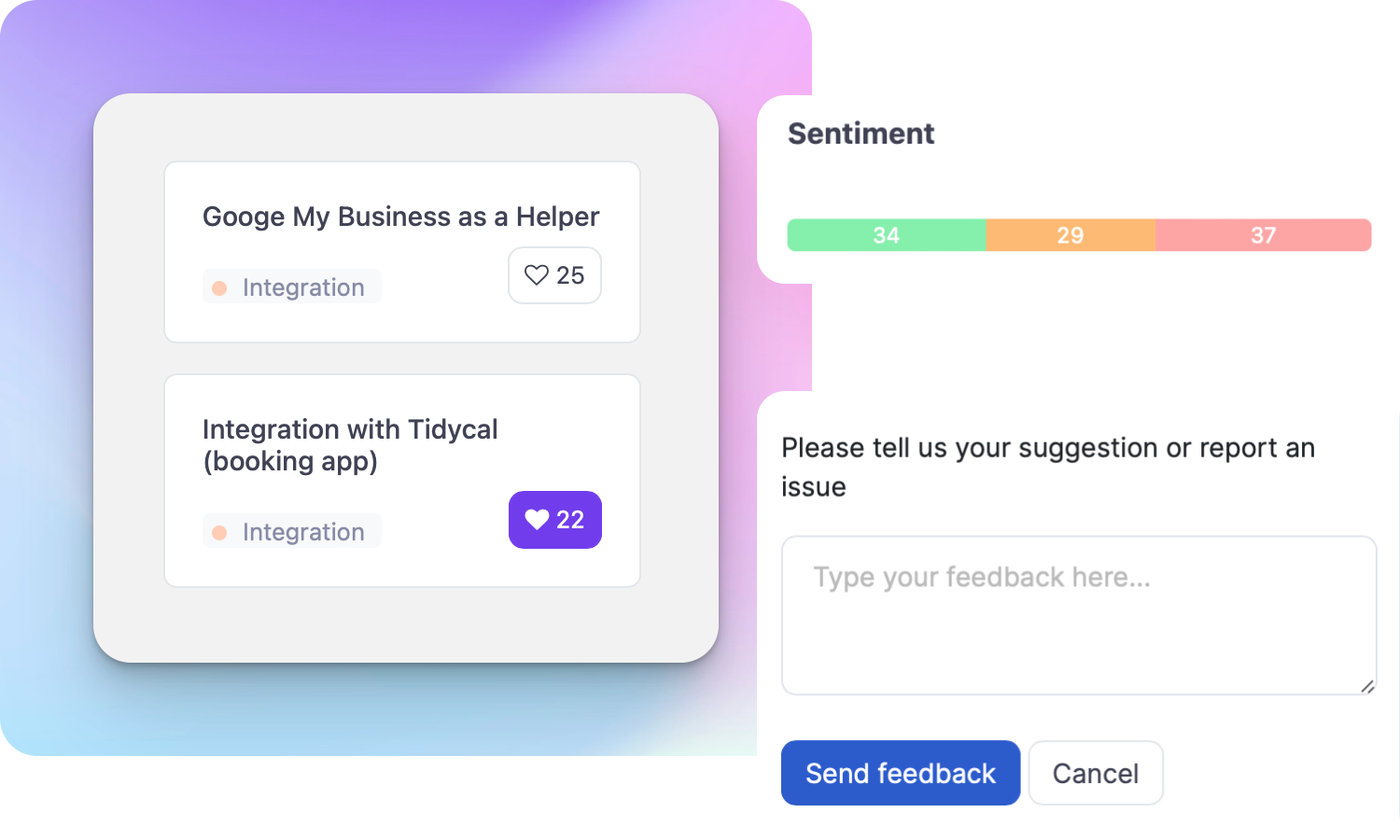Integrating Customer Feedback for a Successful Product Launch

Ruben Buijs
Updated on Jul 14, 2024
Leveraging customer feedback is key to aligning your product with market needs and customer desires. This guide covers the steps and strategies for using feedback to plan, launch, and refine your product successfully.
Introduction to Product Launches
Launching a new or updated product is a pivotal moment for any company. It's the process where your product becomes available to customers. A successful product launch requires deep market research, understanding customer needs, and standing out from the competition. Defining your target audience and creating a buyer persona will guide your product development and marketing efforts, ensuring your product resonates with potential customers.
The Product Launch Checklist
To launch a successful product, you need to do market research, identify your target audience, and understand your competition.
1. Thorough Market Research
Before launching, you need a comprehensive understanding of market trends, customer preferences, and the competitive landscape. This research will help tailor your product to meet market demands effectively.
2. Define Your Target Audience
Identify who your ideal customers are and create detailed buyer personas. This helps in crafting messages that resonate and compel action, ensuring your marketing efforts are well-targeted.
3. Assess the Competition
Understand what your competitors are offering and how your product stands out. This will help you position your product favorably in the minds of consumers.
Steps for a Successful Product Launch
-
Validate Your Product Concept
-
Engage with customers early to gather feedback on your product concept.
-
Incorporate their insights to refine and validate your product idea.
-
-
Prototyping and Feedback
-
Test your product with real users and iterate based on their feedback.
-
This phase is crucial for identifying any issues and making necessary improvements.
-
-
Define Your Launch Goals
-
Set clear and measurable objectives for your launch.
-
These goals will guide your strategy and help measure success.
-
-
Prepare Your Marketing Collateral
-
Develop marketing materials that speak directly to your buyer personas.
-
Use the channels and language that resonate with your target audience.
-
-
Develop a Launch Timeline
-
Create a detailed timeline that outlines all key activities and deadlines.
-
This will help keep your launch organized and on track.
-
-
Plan Post-Launch Activities
-
Prepare for customer support and gather post-launch feedback.
-
Be ready to adapt based on customer responses and feedback.
-
You will see this results into quite an action list. You can keep track of actions in a tool such as ProductLift.
Using Customer Feedback to Improve Your Product Launch
1. Make Feedback Easy to Provide
Ensure that providing feedback is simple and convenient for your customers. Use multiple channels such as surveys, focus groups, and online forums. An easy feedback process encourages more responses, providing a broader data set to analyze.
Surveys: Tools like SurveyMonkey or Google Forms are great for structured feedback.
Feedback Portals: Centralize feedback with tools like ProductLift to consolidate and prioritize customer insights.
Customer Support: Analyze support tickets and chat logs for recurring issues.
Social Media: Monitor platforms for unsolicited feedback and trends.
Product Reviews: Check review sites for customer opinions.
Direct Feedback: Use email and feedback forms integrated within your software.
Feedback Widgets: Subtle in-app widgets can gather feedback without disrupting the user experience.
2. Structured Feedback Management
Develop a systematic approach to collect and analyze feedback. Regular surveys with specific questions about product features, user experience, and potential improvements can yield actionable insights.
-
Categorize Feedback: Group feedback into categories like usability, features, and performance.
-
Identify Patterns: Look for recurring themes and common issues.
-
Sentiment Analysis: Use tools to understand the emotional tone behind the feedback.
-
Quantify Feedback: Determine the frequency of specific issues or requests.
3. Act on Feedback Quickly
Responding promptly to feedback shows customers that their opinions are valued. Prioritize features and implement changes that can significantly impact the product's effectiveness and customers' perceptions before launch.
-
Impact vs. Effort Matrix: Evaluate the potential impact of each update against the effort required.
-
Customer Segmentation: Consider the needs of different user segments.
-
Alignment with Business Goals: Ensure updates align with your business strategy.
-
Competitive Analysis: Position your product favorably against competitors.
-
ICE scoring: Evaluate the Impact and Ease (similar like Impact vs Effort), but also include Confidence.
4. Communicate During Beta Testing
Beta testing is a crucial phase where early adopters provide valuable feedback. Transparent communication about the testing process builds trust and positively influences customer satisfaction.
-
Identify Bugs and Usability Issues: Use feedback to improve the product's quality.
-
Validate Product Features: Ensure features meet target audience needs.
-
Refine the Product: Make necessary changes based on feedback to enhance customer satisfaction.
5. Feedback-Driven Product Development
Customer feedback can reveal flaws or enhancements that might be overlooked. Incorporate feedback into your development process to ensure the final product meets customer expectations.
-
Feedback Loop: Evaluate and prioritize insights for user satisfaction and product success.
-
Actionable Insights: Use feedback to guide development, from minor tweaks to significant overhauls.
-
Roadmap: Create and share your public roadmap with users
6. Feedback-Informed Marketing Materials
Customer testimonials and data-driven results from feedback can enhance marketing materials. Authentic customer experiences are powerful and can drive a successful product launch.
-
Create Marketing Campaigns: Reflect the product's benefits accurately.
-
Inform Pricing: Ensure the product is competitively priced and appeals to the target audience.
7. Enhancing Customer Satisfaction and Service
Post-launch, continue gathering feedback to improve customer service and satisfaction. Addressing concerns and praises can build a strong foundation for future sales and loyalty.
-
Identify Improvement Areas: Use feedback to enhance the product and customer service.
-
Evaluate and Iterate: Gather feedback on updates and track key performance indicators (KPIs).
8. Planning for Future Product Updates
Use customer feedback to plan future updates, ensuring the product evolves with customer needs.
-
Internal Communication: Keep your team informed about planned updates.
-
Customer Communication: Inform customers about upcoming changes and how their feedback is used.
-
Changelogs: Publish detailed logs with each update to highlight new features and improvements.
Useful Tips for Product Launch
Here are some additional tips to help you make the most of your product launch:
-
Engage Influencers: Collaborate with industry influencers, bloggers, or experts who can help amplify your launch through their networks and reach.
-
Leverage Early Access: Offer exclusive early access to a select group of customers or provide beta testing opportunities. This not only builds anticipation but also allows you to gather valuable feedback before the official launch.
-
Encourage User-generated Content: Encourage users to share their experiences with your product on social media or through reviews. User-generated content acts as social proof and can significantly boost your product's credibility.
-
Provide Exceptional Support: Ensure that your customer support team is well-prepared to handle inquiries and provide assistance promptly. Prompt and reliable support builds trust and enhances the overall customer experience.
-
Continued Marketing Efforts: Don't let the momentum fade after the initial launch. Continue to invest in marketing efforts, such as content creation, SEO optimization, and targeted advertising, to sustain the product's growth and attract new customers.
The Best Tool for Customer Feedback Management
A well-timed and strategically planned product launch can significantly impact your product's success. ProductLift helps you capture, organize, and prioritize feedback, ensuring that your product strategy is driven by customer insights.
Key Features of ProductLift
-
Centralized Feedback Organization
- Gather feedback from various channels and integrations like emails, Slack, and in-app widgets.
-
Accessible to Everyone
- Centralize feedback data in one place for easy access and prioritization.
-
Shared Across Teams
- A central hub for customer-facing teams to access and submit feedback.
-
Prioritize and Analyze Feedback
- Make feedback-driven decisions based on the impact and prevalence of requests.
With ProductLift, you can collect, analyze, and organize feedback, engaging with customers throughout the development process. Features include feedback collection via widgets, feedback segmentation, embedding roadmaps, and closing the feedback loop.
Conclusion
A successful product launch relies on understanding your market, defining your target audience, and leveraging customer feedback. By following the steps outlined in this guide and using tools like ProductLift, you can ensure that your product meets customer needs and stands out in a competitive market.
Sign up for ProductLift and set up a complete customer feedback management system to make your product launch a success.











